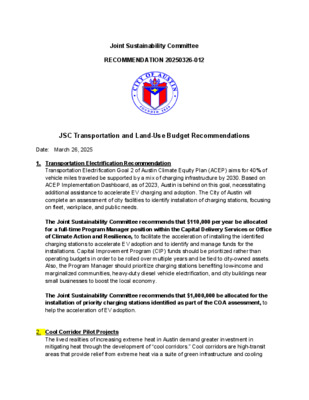Recommendation 20250326-012 - JSC Transportation and Land-Use Budget Recommendations — original pdf
Recommendation

Joint Sustainability Committee RECOMMENDATION 20250326-012 JSC Transportation and Land-Use Budget Recommendations Date: March 26, 2025 1. Transportation Electrification Recommendation Transportation Electrification Goal 2 of Austin Climate Equity Plan (ACEP) aims for 40% of vehicle miles traveled be supported by a mix of charging infrastructure by 2030. Based on ACEP Implementation Dashboard, as of 2023, Austin is behind on this goal, necessitating additional assistance to accelerate EV charging and adoption. The City of Austin will complete an assessment of city facilities to identify installation of charging stations, focusing on fleet, workplace, and public needs. The Joint Sustainability Committee recommends that $110,000 per year be allocated for a full-time Program Manager position within the Capital Delivery Services or Office of Climate Action and Resilience, to facilitate the acceleration of installing the identified charging stations to accelerate EV adoption and to identify and manage funds for the installations. Capital Improvement Program (CIP) funds should be prioritized rather than operating budgets in order to be rolled over multiple years and be tied to city-owned assets. Also, the Program Manager should prioritize charging stations benefiting low-income and marginalized communities, heavy-duty diesel vehicle electrification, and city buildings near small businesses to boost the local economy. The Joint Sustainability Committee recommends that $1,000,000 be allocated for the installation of priority charging stations identified as part of the COA assessment, to help the acceleration of EV adoption. 2. Cool Corridor Pilot Projects The lived realities of increasing extreme heat in Austin demand greater investment in mitigating heat through the development of “cool corridors.” Cool corridors are high-transit areas that provide relief from extreme heat via a suite of green infrastructure and cooling amenities, including shade structures, water fountains, drought-tolerant trees, and other vegetation and plantings. Cool corridors offer multiple benefits, including improved air and water quality, reduced heat island impacts and tree canopy disparities, increased walkability, bikeability, and transit ridership, neighborhood greening and beautification, and improved health outcomes and quality of life. Creating cool corridors serves ACEP Transportation and Land Use Goal 3, "50% of trips in Austin are made using public transit, biking, walking, carpooling, or avoided altogether by working from home" through strategies 3 (enhance transit stops and stations), 4 (prioritize bicycle networks), and 6 (improve sidewalks, urban trails, and crossings). Cool corridors also support the ACEP Natural Systems Goal 3, “Achieve at least 50% citywide tree canopy cover by 2050, focusing on increasing canopy cover equitably.” Additional funding is needed to implement cool corridor pilot projects and support ongoing care and maintenance of cool corridors and the existing urban tree canopy via community stewardship programs. These projects should align with existing plans to install bus shelters, bike paths, sidewalks, and other updated infrastructure in chosen corridors and focus on areas with disproportionate heat burdens, low tree canopy cover and that have been historically disinvested, specifically in Austin’s Eastern Crescent. The Joint Sustainability Committee recommends that $2,000,000 be allocated to support the implementation and maintenance of cool corridors in high-heat transit corridors, including via the installation of green infrastructure and shade amenities in public and private parks, community spaces, transit stops and centers, along urban trails and sidewalks, and along the right-of-way. 3. Resilience Coordinator Extreme heat, drought, flooding and poor air quality threaten the health, safety, and quality of life of Austinites, especially children, the elderly, low-income populations, communities of color, and outdoor workers. To mitigate these impacts, the City of Austin will need to coordinate across departments to implement climate resilience and green infrastructure projects throughout the city, including the conversion of impervious cover to green cover, tree planting and shade structure projects, and the installation of bioswales, rain gardens, drought-tolerant vegetation, and other shade/cooling amenities and nature-based solutions along “Cool Corridors.” To enable these projects, additional staff capacity is needed to coordinate resilient and green infrastructure projects in partnership with community stakeholders and City departments. A new FTE within OCAR can support research on best management practices for climate resilience and implementation of priority actions identified by the comprehensive climate implementation program (CCIP), Austin Heat Resilience Playbook, and other climate resilience strategies in accordance with the Austin Climate Equity Plan. The Joint Sustainability Committee recommends that $90,000 per year be allocated to the Office of Climate Action and Resilience for an Environmental Program Coordinator to build organizational capacity for climate resilience projects and partnerships. Vote: 11-0 Motion: Charlotte Davis Second: Rodrigo Leal Against: Abstain: Off Dais: Attest: Rohan Lilauwala, Staff Liaison For: Anna Scott, Haris Qureshi, Kaiba White, Charlotte Davis, Heather Houser, Christopher Campbell, Marissa Bell, Lane Becker, Rodrigo Leal, Melissa Rothrock, Yure Suarez Absent: Chris Maxwell-Gaines, Amy Noel, Chris Crookham, Alberta Phillips, Diana Wheeler